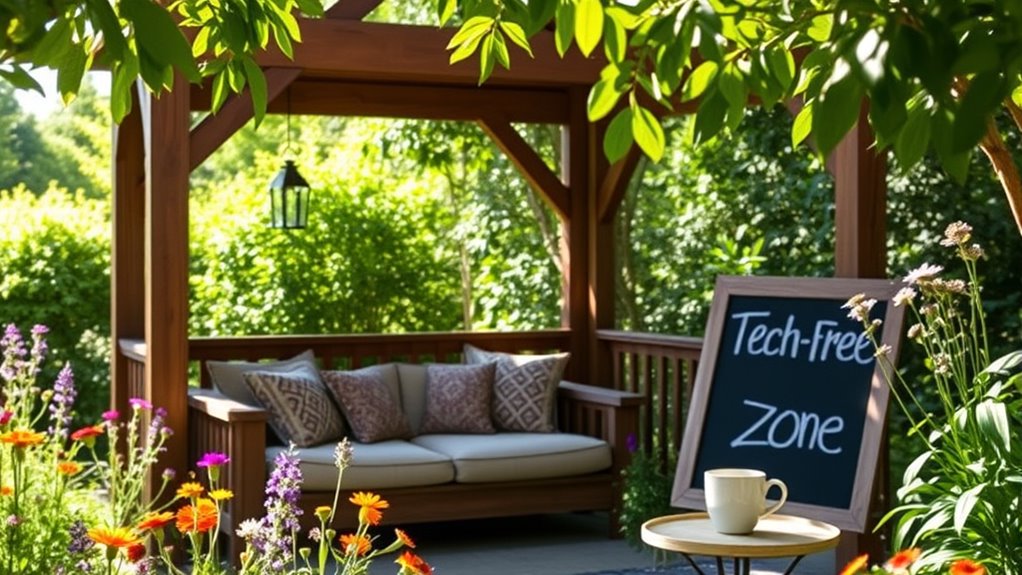To set up effective tech-free zones, choose strategic locations like dining areas, bedrooms, or cozy corners for activities like reading or meditation. Remove or hide devices, using storage containers or physical barriers to prevent temptation. Involve everyone in establishing boundaries and enforce collective respect. Creating designated spaces helps you reclaim mental clarity, boost face-to-face connections, and develop a balanced lifestyle. Continue exploring simple tips to make these zones work seamlessly for your daily life.
Key Takeaways
- Choose strategic locations like dining areas or cozy corners to create dedicated tech-free zones.
- Remove or hide devices, using storage solutions to minimize temptation and clutter.
- Establish clear boundaries and communicate them to all household members for collective respect.
- Incorporate visual cues and physical barriers to reinforce disconnection within designated areas.
- Encourage activities like reading, meditation, or conversations to maximize benefits of the tech-free retreat.

In today’s hyperconnected world, taking a break from screens can feel overwhelming, but a DIY digital detox is both manageable and rewarding. One of the most effective ways to reclaim your time and mental space is by setting up tech-free zones within your home. Creating designated areas where devices are off-limits allows you to establish mindful boundaries, helping you resist the constant pull of notifications and digital distractions. Think of these zones as sanctuaries for focused activities, relaxation, or meaningful face-to-face interactions. By intentionally designating certain rooms or spaces as tech-free, you reinforce your commitment to digital minimalism—reducing clutter and overstimulation from screens.
Creating tech-free zones helps you reclaim mental space and foster meaningful face-to-face connections.
Start by choosing strategic locations in your home where screens aren’t allowed. The dining room, for example, is ideal for fostering family conversations without interruptions from devices. Your bedroom can become a haven for rest and intimacy by keeping phones and tablets out of sight. Even a cozy corner dedicated to reading, meditation, or hobbies can serve as a tech-free retreat within your busy environment. The key is consistency; the more you stick to these boundaries, the easier it becomes to resist the urge to check your devices constantly. Over time, these zones help rewire your habits, making mindful boundaries second nature.
To enhance your digital minimalism efforts, consider removing or hiding devices in these zones. Use baskets or storage containers to keep gadgets out of sight when not in use. Place chargers and cords elsewhere to avoid temptation and create physical barriers to device access. This visual cue reminds you of your intention to disconnect and focus on the present moment. Also, inform family members or housemates about your zones, encouraging everyone to respect these boundaries. This collective effort reinforces your commitment and makes the experience more effective.
Creating tech-free zones isn’t just about limiting screen time—it’s about redesigning your environment to support your mental well-being. These spaces serve as reminders that life exists beyond digital devices, encouraging you to engage more deeply with your surroundings and relationships. Incorporating mindful boundaries can also help prevent feelings of running dry and fatigue that often result from digital overexposure. Over time, you’ll notice a shift towards a more intentional, balanced lifestyle. Setting up these zones is a simple yet powerful step toward digital minimalism, helping you regain control over your digital habits. With mindful boundaries in place, you’ll find it easier to disconnect, recharge, and enjoy the present moment—free from the constant buzz of screens.
Frequently Asked Questions
How Long Should a Digital Detox Retreat Last?
A digital detox retreat should last at least 24 to 48 hours to effectively reduce screen time and boost mental clarity. During this period, you disconnect from devices, allowing your mind to reset and regain focus. Longer retreats, like a weekend or a week, deepen these benefits, helping you break habits and restore balance. Listen to your needs, but remember, even short breaks can profoundly improve your mental health and overall well-being.
What Activities Are Best for a Tech-Free Zone?
Imagine stepping into your own peaceful oasis, like a modern-day monastery. You should prioritize meditation practices and creative activities, such as painting, journaling, or crafting. These activities help you reconnect with yourself and nature, free from digital distractions. Encourage mindfulness through breathing exercises, and explore your artistic side. By focusing on these wholesome activities, you’ll foster relaxation, clarity, and genuine connection during your tech-free retreat.
How Do I Communicate My Tech-Free Plans to Others?
You should clearly communicate your tech-free plans by explaining your reasons, like privacy concerns or the need for genuine connections, to manage social expectations. Be honest and kind, emphasizing that this retreat helps you recharge and stay present. Offer alternatives, like scheduled check-ins or designated times for communication, to reassure others. This openness encourages understanding and respect for your boundaries, making your tech-free zone successful.
What if I Experience Withdrawal Symptoms?
Remember, “patience is a virtue.” If you experience withdrawal symptoms, don’t panic. Acknowledge your feelings and use coping strategies like deep breathing, journaling, or taking a walk. Stay committed to your detox plan, and gradually, these symptoms will lessen. Keep reminding yourself why you started, and trust that this effort will lead to healthier habits and a clearer mind. You’ve got this!
Can I Include Children in a Digital Detox Retreat?
Yes, you can include children in a digital detox retreat. Focus on family involvement by planning fun, engaging children’s activities that encourage interaction and creativity. Keep tech-free zones safe and appealing for kids, offering outdoor games, storytelling, or arts and crafts. By involving children actively, you help them understand the benefits of unplugging while creating a positive, shared experience that promotes stronger family bonds during the retreat.
Conclusion
As you create your tech-free zones, you might notice unexpected moments of clarity or a sudden urge to reconnect with loved ones—coincidences that remind you how invigorating life can be without constant screens. Embrace these small surprises as signs you’re on the right path. Your digital detox isn’t just about unplugging; it’s about rediscovering what truly matters. So, keep setting up those zones—you never know what meaningful moments might happen when you least expect them.









